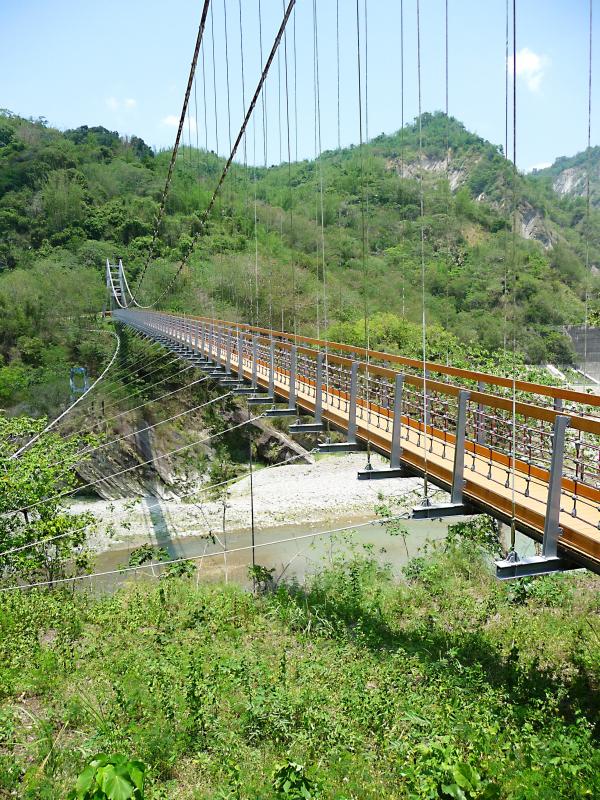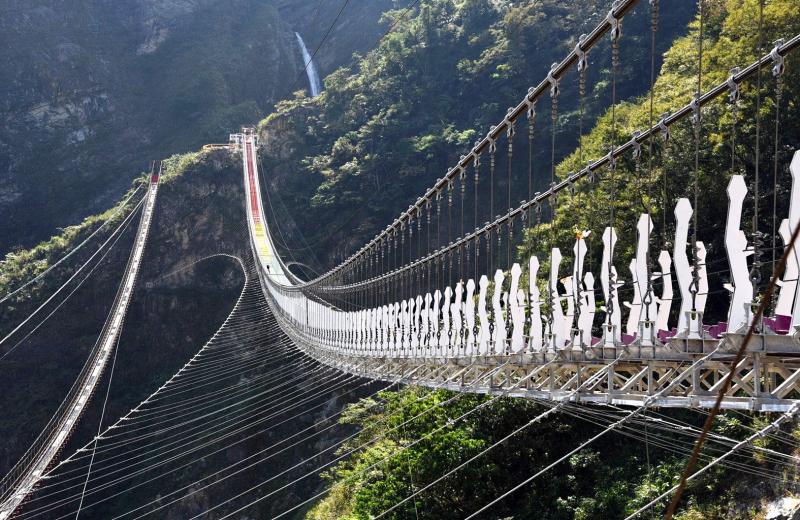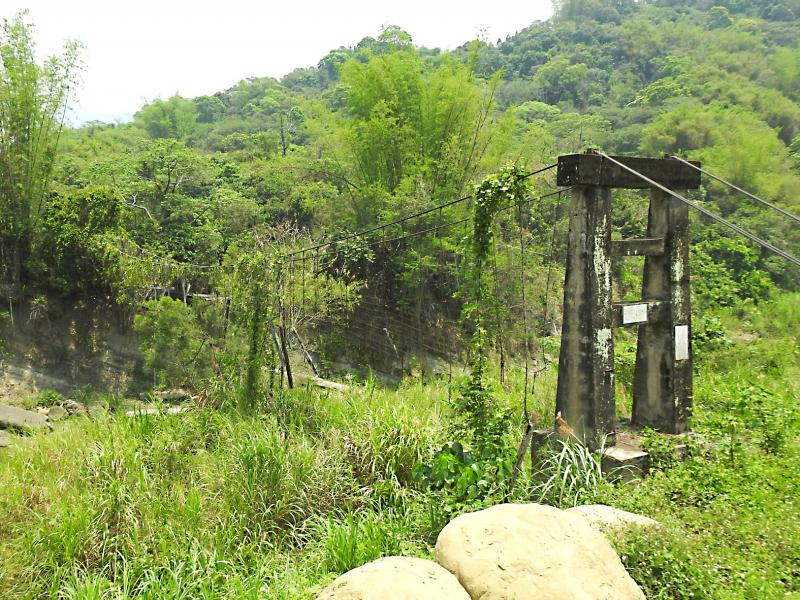In Taiwan’s foothills, suspension bridges — or the remnants of them — are almost as commonplace as temples.
“Suspension bridge” is a direct translation of the Chinese-language term (吊橋, diaoqiao), but it’s a little misleading. These spans aren’t huge pieces of infrastructure. The larger ones are just wide enough for the little trucks used by farmers. Others are suitable for two-wheelers and wheelbarrows. If one end is higher than the other, they may incorporate steps, like the recently-inaugurated, pedestrians-only Shuanglong Rainbow Suspension Bridge (雙龍七彩吊橋) in Nantou County.
Because torrential rains hammer Taiwan during the hot season, the landscape is scarred by ravines and wadis. Fording certain creeks is out of the question. After World War II, bridges made of steel wires and wooden planks, held in place by a concrete tower on either side, made it possible for remote hill farmers to get their crops to market, and for their children to attend school.

Photo: Steven Crook
In the past few decades, many suspension bridges have been superseded by bigger structures able to carry two-way traffic. Several old bridges have been left to collapse, like one beside Taichung Local Road 100 in Taiping District (太平). In a tropical climate, the wooden elements quickly rot. The hawsers anchored to each side are more durable, but may snap if struck by falling rocks (a significant threat in mountainous areas) or stretched because one of the towers has toppled.
Others are properly maintained or replaced, and have become tourist attractions. When I reached the northern end of Provincial Highway 21, after the most challenging section of one of the most difficult bike rides I’ve ever done, I spent a good bit of time on Fusing Suspension Bridge (福興吊橋), taking in the scenery and catching my breath before returning to the road.
The 150m-long bridge crosses the Dajia River (大甲溪), which here divides Taichung’s Sinshe (新社) and Dongshih (東勢) districts. Its current form dates from 2013; previous editions were of great importance to those living nearby, as there was no road bridge here until 1971.

Photo: Hsieh Chieh-yu
I’ve not had a chance to visit Shuanglong Rainbow Suspension Bridge (雙龍七彩吊橋), but back in 2015 I did get to see the original bridge. The older structure — which remains in place, parallel to the new one — wasn’t built so people could cross the valley, but to support and maintain a pipe which carries water to the nearby indigenous village.
At the time of my visit, signs informed outsiders that anyone making an unauthorized crossing of the pipe-bridge would have to pay a fine. In the hour or two I spent there with friends, at least four people ignored the warning and went all the way across to get a closer look at Shuanglong Waterfall (雙龍瀑布). I didn’t, and not simply because it was prohibited. It looked terrifying.
Back in the late 1990s, a suspension bridge in the mountains caused me a moment of horror, and I wasn’t even on it. Camping alone without a tent in what’s now Kaohsiung’s Taoyuan District (桃源), I’d settled down for the night beside a tiny stream, not really noticing the bridge almost directly above me.

Photo: Steven Crook
Sometime later, echoing thuds wrenched me from deep sleep and out of my sleeping bag. When my head cleared, I realized a truck had clattered at speed across the bridge. My brain, interpreting the noise as a rockslide, had pushed the panic button.
More recently, I’ve ridden my bike across what’s said to be the longest steel-cable footbridge in Taiwan.
The 360m-long Shuangshih Suspension Bridge (雙十吊橋) crosses the Wu River (烏溪) in Nantou County’s Caotun Township (草屯鎮). A relief image on the river’s north bank celebrates the life and works of Lin Chi-mu (林枝木, 1930-2003), the engineer who oversaw its construction in 1977.

Photo: Steven Crook
Lin began his bridge-building career at the age of 18, and played a role in the building of over 150 bridges throughout Taiwan, among them: Baling Suspension Bridge (巴陵吊橋) beside Highway 7 in Taoyuan; Wulai Suspension Bridge (烏來吊橋) in New Taipei City; and the original version of Pudu Bridge (普渡橋) at Tiansiang (天祥) in Taroko National Park.
In an interview he gave shortly before his death, Lin said that the cost of building a 150m-long suspension bridge is about one tenth of that of a concrete bridge of similar length, and the former can often be completed in less than four months.
When working in remote locations, he usually slept and cooked on-site, sometimes accompanied by his wife. Getting the first rope across the defile was often difficult and dangerous; one man would have to climb down, then swim across. Once a zip line had been set up, workers and materials could be sent over. During his career, Lin lost three teammates to accidents.
Several of Taiwan’s steel-cable footbridges enhance the scenery in which they’ve been set. Neiyechi Suspension Bridge (內葉翅吊橋) is in this category, even if it’s hard to reach.
The bridge crosses the Zengwen River (曾文溪) where it flows out of Alishan Township (阿里山鄉) and into Dapu Township (大埔鄉). And, in my opinion, the bilingual sign pointing to it at intersection of Provincial Highway 3 and Chiayi Local Road 133 borders on the irresponsible. City slickers who try to drive to it will at best struggle on this rough and narrow road, and at worst damage their vehicles.
It’s 2.3km from Highway 3 to the southern end of the 164m-long bridge. Looking down as I pushed my motorcycle across, I could see fragments of an earlier bridge destroyed by Typhoon Morakot in 2009.
The northern end is much closer to a decent road, but I didn’t enjoy riding up the twisting track. It was steep, and much of the surface was rutted or shattered.
After Morakot, the government spent NT$47 million to rebuild Neiyechi Suspension Bridge. Last year, a budget of NT$15 million was approved to reinforce the bridge, strengthen the side fencing, and replace the planking with plasticized wood. It seems the authorities have lots of money for a bridge that no one actually needs, but not enough to improve the roads that lead to it. Do they want tourists to enjoy it or not?
Steven Crook has been writing about travel, culture, and business in Taiwan since 1996. He is the co-author of A Culinary History of Taipei: Beyond Pork and Ponlai, and author of Taiwan: The Bradt Travel Guide, the third edition of which has just been published.

This month the government ordered a one-year block of Xiaohongshu (小紅書) or Rednote, a Chinese social media platform with more than 3 million users in Taiwan. The government pointed to widespread fraud activity on the platform, along with cybersecurity failures. Officials said that they had reached out to the company and asked it to change. However, they received no response. The pro-China parties, the Chinese Nationalist Party (KMT) and Taiwan People’s Party (TPP), immediately swung into action, denouncing the ban as an attack on free speech. This “free speech” claim was then echoed by the People’s Republic of China (PRC),

Exceptions to the rule are sometimes revealing. For a brief few years, there was an emerging ideological split between the Democratic Progressive Party (DPP) and Chinese Nationalist Party (KMT) that appeared to be pushing the DPP in a direction that would be considered more liberal, and the KMT more conservative. In the previous column, “The KMT-DPP’s bureaucrat-led developmental state” (Dec. 11, page 12), we examined how Taiwan’s democratic system developed, and how both the two main parties largely accepted a similar consensus on how Taiwan should be run domestically and did not split along the left-right lines more familiar in

Specialty sandwiches loaded with the contents of an entire charcuterie board, overflowing with sauces, creams and all manner of creative add-ons, is perhaps one of the biggest global food trends of this year. From London to New York, lines form down the block for mortadella, burrata, pistachio and more stuffed between slices of fresh sourdough, rye or focaccia. To try the trend in Taipei, Munchies Mafia is for sure the spot — could this be the best sandwich in town? Carlos from Spain and Sergio from Mexico opened this spot just seven months ago. The two met working in the

Many people in Taiwan first learned about universal basic income (UBI) — the idea that the government should provide regular, no-strings-attached payments to each citizen — in 2019. While seeking the Democratic nomination for the 2020 US presidential election, Andrew Yang, a politician of Taiwanese descent, said that, if elected, he’d institute a UBI of US$1,000 per month to “get the economic boot off of people’s throats, allowing them to lift their heads up, breathe, and get excited for the future.” His campaign petered out, but the concept of UBI hasn’t gone away. Throughout the industrialized world, there are fears that